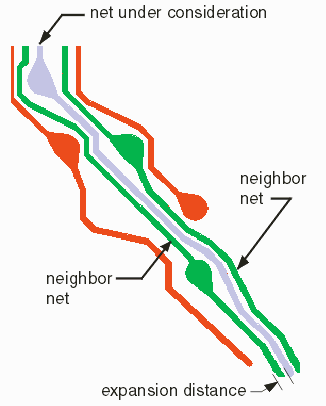

|
Neighbor NetsIf you are using NETEX-G to extract the conductors for a net or nets and you plan to use the data to create a SPICE equivalent model of the layout, then you will also be interested in nearby nets that may inductively couple to the net under consideration. We call these nearby nets "neighbor" nets. The user defines an expansion distance which used to see which nets qualify as neighbor nets. It is not possible for the NETEX-G program to actually measure the whether a nearby net runs "parallel" or "perpendicular" to the net under consideration. 
The blue net is the one to analyze. The green nets, because they overlap the area defined by the net under consideration + expansion distance, are neighbor nets. The red nets are not considered neighbor nets. |
How the Neighbor Nets are ReportedNeighbor nets are reported by net name in a separate ascii file called the coupling file (the default suffix for the coupling file is .cpl) The coupling file is very easy to interpet. The name of each net analyzed is followed by a list of net names that couple to it. If no nets couple to it the name is still listed but it is followed by a blank line. NET-1 NET-15 NET-16 NET-2 NET-16 NET-17 NET-22 NET-3 NET-4 NET-11 NET-12 . . . |